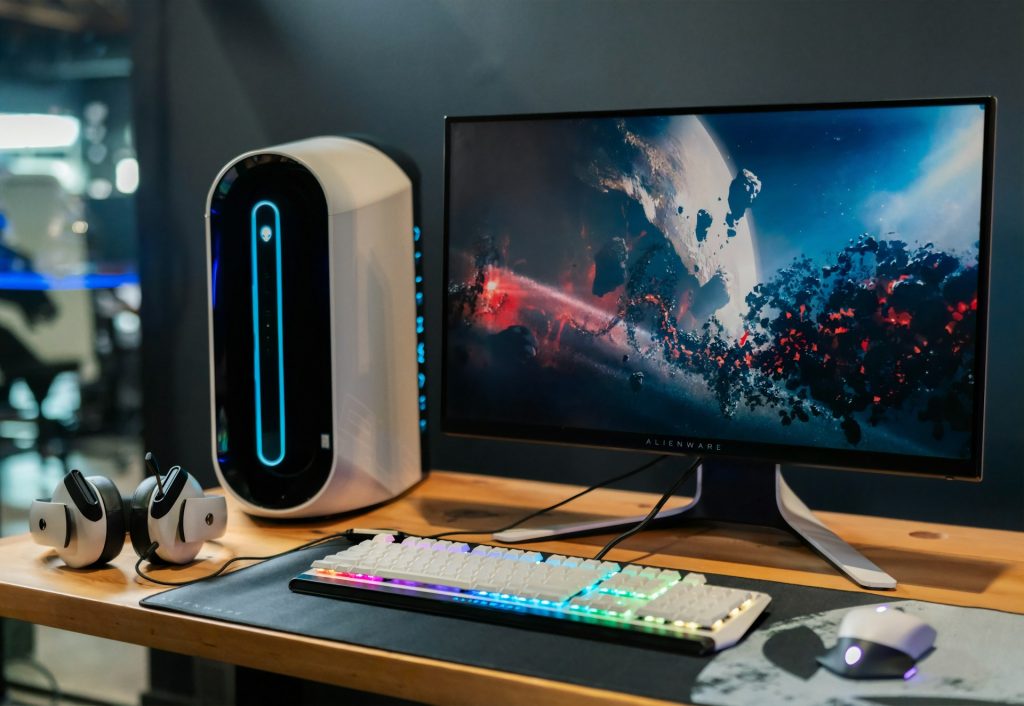When it comes to computer setup, selecting the correct monitor size can significantly impact your user experience. Choosing between a 24-inch versus a 27-inch monitor often leaves consumers in a quandary, with both sizes offering unique benefits. This article compares the 24-inch versus 27-inch monitor, considering various factors such as resolution, space, usability, and price. The goal is to guide you in making an informed decision when choosing the monitor size that best suits your needs.
Comparison of 24 Inch and 27 Inch Monitors
Several factors are at play regarding the comparison between 24-inch and 27-inch monitors. This will delve into the detailed aspects, including their resolution, usability, space requirement, and price, to help you understand which monitor size would better serve your computing requirements.
Image Quality
When choosing between a 24-inch and a 27-inch monitor, a critical factor is image quality, primarily determined by resolution, pixel density, and color accuracy. Resolution essentially defines the number of pixels displayed on the screen: the higher the resolution, the sharper and clearer the image. In a scenario where both monitors have the same resolution, the smaller 24-inch monitor will have a higher pixel density, resulting in sharper images.
However, a 27-inch monitor offers additional screen real estate, which can be beneficial for multitasking or using applications with complex interfaces. It’s important to note that a larger monitor may require a higher resolution to maintain the same level of clarity as a smaller monitor. For instance, a 27-inch monitor ideally has a 1440p resolution for optimal image quality, while a 24-inch monitor may suffice with 1080p.
Color accuracy is another under-discussed aspect of image quality, crucial for tasks such as photo editing or graphic design. Generally, more expensive monitors will have better color accuracy, but this isn’t necessarily tied to monitor size.
Furthermore, with the rising trend of using vertical monitors, which involve rotating the monitor 90 degrees for a portrait view, the 24-inch vs. 27-inch debate takes on a new dimension. A vertical monitor can enhance productivity, especially in coding or reading tasks. However, a 27-inch monitor, due to its larger size, may not lend itself as well to the vertical orientation as a 24-inch one. Ultimately, choosing between a 24-inch and a 27-inch monitor for vertical usage will depend on your needs and workspace constraints.
Compatible Options
Another important aspect to consider when evaluating the 24-inch vs. 27-inch monitor debate is the compatibility of your existing devices and accessories with each monitor size. This compatibility extends to the range of devices you might want to connect to the monitor, including laptops, game consoles, external storage devices, and accessories like monitor stands, soundbars, or screen protectors.
The physical dimensions of a 24-inch monitor might limit the number of ports and, hence, the number of devices that can be simultaneously connected. On the other hand, a 27-inch monitor generally has more space for multiple ports, allowing for a greater number of connections. However, remember that the number and type of ports can vary across different models, irrespective of their size.
Accessory compatibility is also crucial. Monitor stands, for example, need to withstand the weight of the monitor. While a 24-inch monitor is lighter and can be supported by most stands, a 27-inch monitor is heavier and might require a more robust stand. Similarly, soundbars and screen protectors should also match the dimensions of the monitor for them to be effective.
Smart Features
One of the most significant advancements in monitor technology is the introduction of smart features, including High Dynamic Range (HDR), adaptive sync, built-in speakers, and touchscreen capabilities. These features can elevate your user experience, making comparing a 24-inch and a 27-inch monitor even more complex.
The ability to display a wider color gamut and achieve higher contrast ratios is an advantage offered by HDR, making images appear more vibrant and lifelike. This feature can particularly benefit gamers and professionals working with visual content.
On the other hand, adaptive sync is a feature designed to reduce screen tearing and stuttering during fast-paced gaming or video playback. This technology synchronizes the refresh rate of your monitor with the frame rate of your graphics card, providing a smoother visual experience.
Built-in speakers can save desk space and reduce cable clutter. While these may not replace high-quality external speakers, they can be sufficient for casual listening or video calls.
A feature that is becoming increasingly popular, especially in a professional setting, is touchscreen capability. A 4K touchscreen monitor, available in both 24-inch and 27-inch sizes, offers the convenience of direct interaction with on-screen content. This feature can be particularly beneficial for creative professionals working with design software, offering higher precision and control. Choosing a 4K touchscreen monitor ultimately depends on your specific needs and how you plan to use your monitor.
Comparing 24-inch vs 27-inch monitors, it’s important to note that larger monitors may provide a more immersive experience when using these smart features. However, choosing between a 24-inch and a 27-inch monitor will ultimately depend on individual requirements, workspace constraints, and budget.
Refresh Rate
The refresh rate of a monitor is a critical factor to consider when comparing 24-inch and 27-inch monitors, particularly for users who are gamers or graphic designers. The refresh rate measures how often the screen updates with new images each second and is measured in hertz (Hz). A higher refresh rate means the image is updated more frequently, leading to smoother transitions and less motion blur. This is especially beneficial in fast-paced games or design applications where precision and smoothness are crucial.
A standard monitor typically has a refresh rate of 60Hz, while gaming monitors often offer higher refresh rates like 120Hz, 144Hz, or even 240Hz for high-end models. These elevated refresh rates can provide a significant advantage in competitive gaming, where reaction times are critical. Also, they contribute to a more immersive and fluid gaming experience.
On the other hand, for graphic designers or video editors, a higher refresh rate ensures smoother and more precise movements, which can be particularly beneficial when working with detailed graphics or animations. However, it’s essential to note that the benefits of a higher refresh rate will only be fully realized if your hardware, like your graphics card, can output at the same rate.
Regarding the 24-inch vs. 27-inch debate, it’s not the size of the monitor but the technology behind it that determines its refresh rate. If you’re a casual user, a standard 60Hz monitor of any size should be sufficient for everyday tasks like browsing the web or working on office documents. But for more specialized tasks like gaming or graphic design, a higher refresh rate monitor would be a worthwhile investment, regardless of whether it’s a 24-inch or a 27-inch display.
Usage – Gaming, Work, Personal
In gaming, work, and personal use, your monitor size can significantly impact your experience. For gaming, a 27-inch monitor can provide a more immersive experience with a larger field of view, especially in games that support a wide aspect ratio. The extra-screen real estate allows gamers to spot details more easily, which can be crucial in competitive gaming scenarios. However, it’s important to note that larger monitors often require more powerful graphic cards to maintain high frame rates, especially at higher resolutions.
Regarding productivity and work-related tasks, a larger monitor, such as a 27-inch, can be beneficial in several ways. It provides more space for multitasking and can accommodate more windows or tabs open simultaneously, enhancing workflow efficiency. For instance, graphic designers, video editors, and digital artists might appreciate the additional workspace for their creative endeavors, while data analysts might find it easier to work with large spreadsheets.
For general personal use, the choice between a 24-inch and a 27-inch monitor comes down to personal preference and the nature of the tasks you typically perform. If you primarily use the computer for browsing the web, watching videos, or casual gaming, a 24-inch monitor with a resolution of 1080p should be more than sufficient. On the other hand, if you’re a movie enthusiast or prefer having multiple applications open at once, a 27-inch monitor might be worth considering.
Installation Method
When setting up your chosen monitor, installation becomes a key consideration. The installation method will vary depending on whether you’re setting up the monitor in a landscape (horizontal) or portrait (vertical) orientation. This becomes particularly relevant in the context of the 24-inch vs. 27-inch monitor debate, as each size might have different considerations for vertical mounting.
Vertical monitor mounting is becoming increasingly popular due to its unique advantages. For tasks such as coding, writing, or web browsing, a vertical monitor setup allows more content to be displayed vertically, reducing the need for constant scrolling. Moreover, given the vertical orientation of most mobile devices, a vertical monitor can provide a better view for developers working on mobile applications.
A process slightly different from traditional monitor installation is involved to setup a vertical monitor. Firstly, you’ll need to check if your monitor stand supports vertical orientation — not all stands. If your existing stand does not support this, you must invest in a stand that offers pivot adjustments or a VESA mount that supports vertical orientation.
Once you’ve secured compatible hardware, the next step is adjusting your display settings. Both Windows and macOS have straightforward settings to change the orientation of your display from landscape to portrait. In the case of a dual monitor setup, you can even set one display to portrait and the other to landscape, providing a versatile workspace.
Despite the benefits of a vertical monitor, there are a few things to note when considering a 24-inch vs 27-inch monitor for vertical setup. A 24-inch monitor, being smaller, might be easier to pivot and may fit better vertically in a typical workspace. However, a 27-inch monitor will provide more screen real estate, which could be beneficial for tasks requiring viewing large amounts of content simultaneously.
In conclusion, when considering a vertical monitor setup, you should consider your work environment, the compatible hardware, and the tasks you most frequently perform. The right choice between a 24-inch and 27-inch monitor for vertical usage will depend on these factors.
Pricing
The cost of monitors can vary considerably, depending on a range of factors such as size, resolution, refresh rate, brand, and additional features. When comparing 24-inch and 27-inch monitors, it’s essential to consider these factors against your personal needs and budget constraints.
In general, 27-inch monitors are more expensive than their 24-inch counterparts due to the larger screen size and often higher resolution. A standard 24-inch monitor with a 1080p resolution is typically the most affordable option, suitable for a wide range of tasks such as browsing the web, watching videos, and casual gaming.
27-inch monitors, on the other hand, often come with a 1440p or even 4K resolution, providing a crisper image and more screen real estate. This is especially useful for tasks that require a high level of detail, such as graphic design or professional gaming. However, these benefits come with a higher price tag. Additionally, as mentioned earlier, a larger monitor may necessitate a more powerful graphics card, which is an additional expense.
The price difference between 24 and 27-inch monitors isn’t just about size and resolution. Features like HDR, adaptive sync, built-in speakers, and touchscreen capabilities can also impact costs. Monitors packed with these high-end features will likely be more expensive, regardless of size.
When considering the price, it’s also important to factor in the cost of any necessary accessories, such as monitor stands or screen protectors. As earlier stated, a larger and heavier monitor might require a more robust stand, which could be an additional expense.
In summary, while a 27-inch monitor offers more features and a larger viewing area, it also has a higher price tag. A 24-inch monitor, while smaller, is more cost-effective and may be more than sufficient for many users’ needs. It’s crucial to evaluate what tasks you’ll be using the monitor for and weigh these against the cost to decide to provide the best value for your specific requirements.
Warranty
A warranty is crucial when purchasing a monitor, whether it’s a 24-inch or 27-inch model. A warranty is not just a protection plan for your monitor; it’s a testament to the manufacturer’s confidence in the durability and reliability of their product. The warranty’s length and coverage can significantly impact your investment’s long-term value and performance.
When comparing warranties, notice whether they cover both parts and labor. A warranty that includes parts and labor is usually more desirable, as it covers the cost of the replacement parts and the service needed to install them. On the other hand, a warranty that covers parts only means you’ll have to pay for the labor out of pocket, which can be costly.
Monitors usually come with a standard one-year warranty, but some manufacturers offer extended warranties lasting up to three years or more. An extended warranty can offer peace of mind, especially when purchasing a high-end monitor. However, it’s important to read the terms and conditions carefully. Some extended warranties might only cover specific parts or require you to ship the monitor to a service center at your expense.
In addition to the manufacturer’s warranty, some retailers offer extended warranty programs. These programs can provide additional coverage beyond the manufacturer’s warranty, covering accidental damage, power surge protection, and even on-site service or replacement.
The size doesn’t directly influence the warranty on the spectrum of 24-inch vs 27-inch monitors. However, since 27-inch monitors are generally more expensive and packed with advanced features, they might be accompanied by longer and more comprehensive warranties. But this is subjective to the brand and the specific model.
Remember, warranty service also requires customer effort, like packaging the product, shipping it, and dealing with customer service. So, it’s worth considering the manufacturer’s reputation for customer service and ease of warranty claims.
In summary, while warranties may not be the deciding factor in choosing between a 24-inch and 27-inch monitor, they certainly merit consideration. A comprehensive warranty can protect your investment and provide peace of mind, ensuring your new monitor delivers an enjoyable user experience for years.
Conclusion
Several factors need consideration beyond size when choosing between a 24-inch and 27-inch monitor. Refresh rate, specific usage, installation method, price, and warranty all play a role. Stay informed, align with your needs, and find the optimal balance between performance, cost, and user experience.



